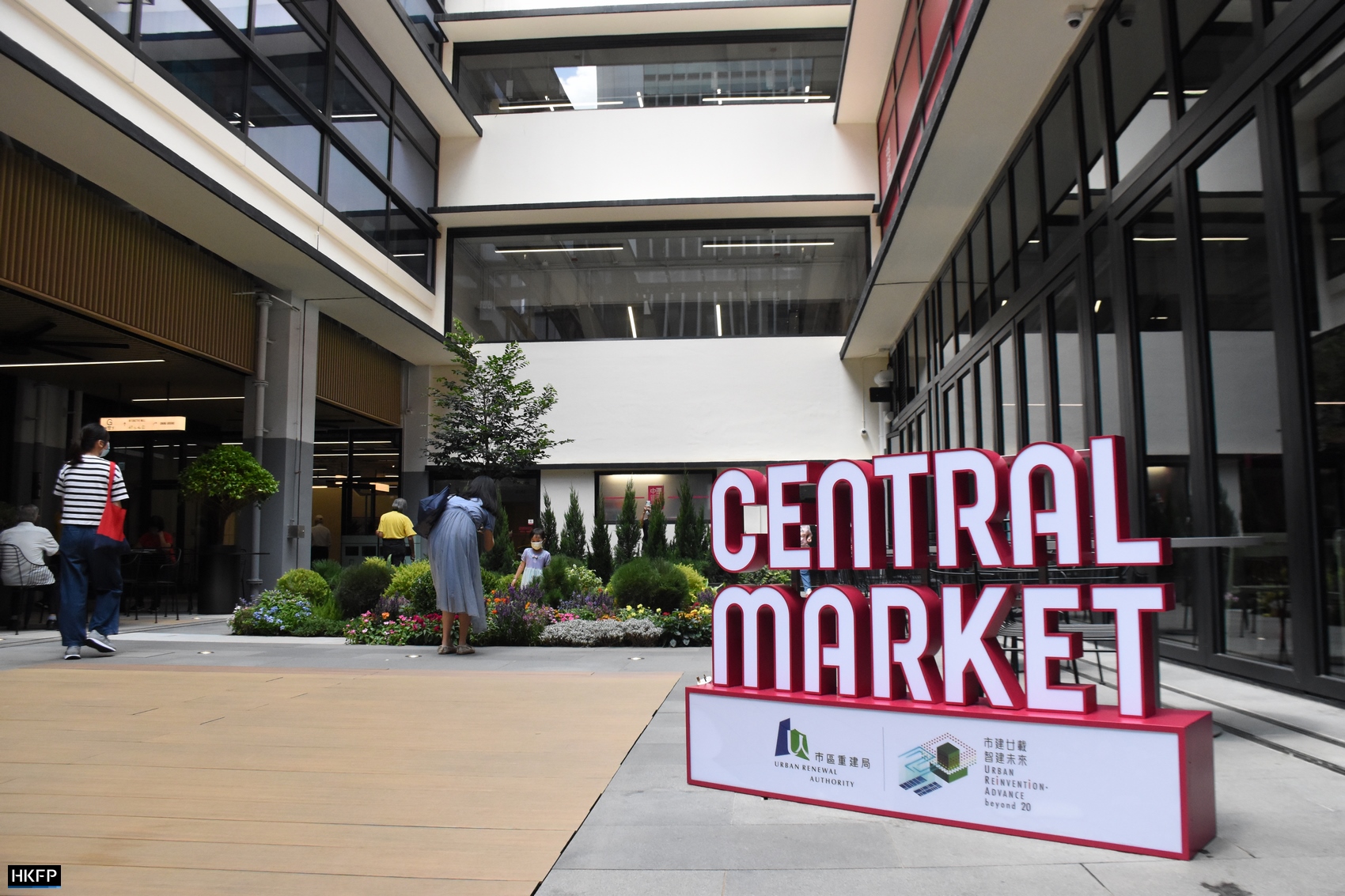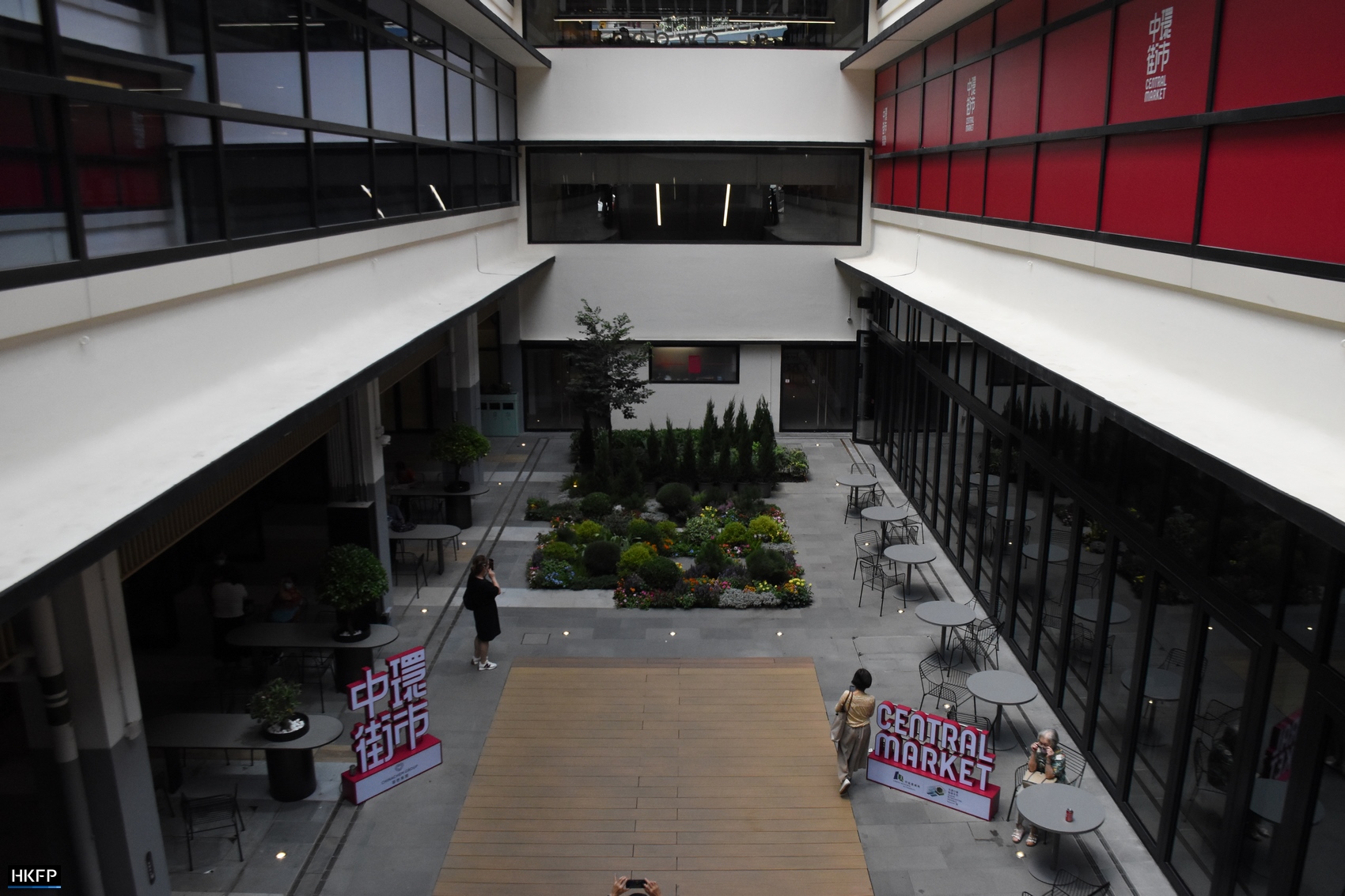Hong Kong has reopened one of its oldest wet markets after three years of construction, rehabilitation and preservation costing more than HK$500 million so far, but one leading local conservationist has given it only a guarded welcome.
The Central Market Revitalisation Project has sparked controversy since it was announced by the then-chief executive Donald Tsang in his policy address in 2009, six years after the market closed.


The 82-year-old building is jointly operated and managed by the Urban Renewal Authority (URA) and the Chinachem group. HKFP visited the market on Wednesday, two days after it reopened, to check out the new look for the building constructed in the Bauhaus style.
Two of the main features of the Central Market before its revitalisation were its small stalls built of terrazzo and two grand staircases at either end of the structure.
The revitalisation project has retained 13 out of the more than 200 market stalls, with much of the rest of the space transformed into open storefronts. Metal railings have been installed on the stairs to comply with modern safety regulations.

Chinachem said that along with the URA it hoped to turn the Central Market into a “playground for all,” and a location catering to local brands and start-up businesses.
“Upholding the spirit of innovation, the Grade 3 historic building has been transformed into a vibrant community hotspot that fully embraces the ‘Approachable, Energetic and Gregarious’ approach in its operation,” it said in a statement.

With around half of its units rented out, the Central Market offers artisan cafes, higher-end grocery stores, food stalls and exhibition space for events. A sushi and sashimi set at a Japanese fine dining restaurant in the Central Market costs HK$1,000, while another sells wagyu beef rice at HK$248 a bowl. Snacks on offer range from vegan ice cream to egg waffles.

The market also displays information panels on the history of the building as well as QR codes explaining certain features of the structure.
‘Nothing related’
Dating from 1939, the current modernist building is the fourth version of the Central Market, a fact described as “very rare” by Katty Law, conservationist and convenor of the Central and Western Concern Group.
Law said that her group had fought to preserve the structure of the market, following initial proposals to add more floors to the four-storey building, and a Central Market Concern Group was set up in 2015.

“Specifically we wanted to suggest that the URA try their best to keep more market stalls, and rent them out to small businesses, instilling the vitality and spirit of a market into the Central Market,” said Law.
The conservationist visited the market on its opening day on Monday but said she failed to see many stores with local characteristics, and the preserved stalls were scattered across the market.

“I’m not sure if it’s the case that they have not found enough stores yet, as it is only partly open, but I think there was not a large variety,” said Law.
“In my expectation, the Central Market is most suitable for stores such as wonton or fish ball noodles. At the moment there’s sushi and red wine.”
Ms. Lam, a visitor to the market, told HKFP that while she felt it would be popular with youngsters as the building as been “modernised,” the market had lost its features.

“I think they just kept the architecture, the outlook of the building, but inside it’s totally nothing related to the market aspect,” said Lam.
Lam and her husband said Wednesday was their second visit to the market, after their first one on opening day when crowds prevented them making a proper tour.
The couple said they had not been sure what to expect. “It was a wet market before. Now we want to understand how so-called revitalisation has transformed [the market],” said Mrs. Lam.

“Ghost” – an HKURBEX team urban explorer who visited the derelict building just before the redevelopment again – told HKFP that the revamp was disrespectful to the markets legacy: “It’s a completely missed opportunity, and quite astounding that it took them over a decade to come up with this result… [T]he project was cursed by bureaucracy from the start – we’ve already seen what happened to Wan Chai’s Lee Tung Street (Wedding Street) and PMQ in Soho, so it’s no surprise really,” he said.
“It’s just a real shame they couldn’t keep the soul or character of Central Market – every city needs a vibrant market that encapsulates the creativity and energy of its people.”

The conservationist said the project shared one of the core problems with redevelopment efforts in Hong Kong – gentrification.
Many of the URA’s projects focus on older districts with a more grassroots demographic. Law said that often residents were displaced and neighbourhoods would disappear during redevelopment.
“In exchange, usually the finished products are luxurious residential buildings, and people who are attracted or able to afford to buy them are of a different class. The pre-existing residents of the neighbourhood will not be able to enjoy it.”

In the case of the Central Market, Law raised questions about rent levels and who would be able to afford a stall in the market, as well as the criteria which the URA and Chinachem used when choosing tenants.
Law said she thought the Central Market should have been a “socially beneficial” project, instead of one for “profit maximisation.”
While there were parts of the market worth praising, such as the courtyard where she was able to have a seat with a friend, “I think there is so much room for improvement.”
Support HKFP | Policies & Ethics | Error/typo? | Contact Us | Newsletter | Transparency & Annual Report | Apps
Help safeguard press freedom & keep HKFP free for all readers by supporting our team

LATEST FROM HKFP
HKFP has an impartial stance, transparent funding, and balanced coverage guided by an Ethics Code and Corrections Policy.
Support press freedom & help us surpass 1,000 monthly Patrons: 100% independent, governed by an ethics code & not-for-profit.








